April 7th, 2014
| 1 Comment »
I have a tendency not to share these dishes we eat, mostly thrown together with ingredients from the fridge that likely need to be used up before they become this years compost material. This ‘Cowboy Cooking’, as Mike calls it, is a strange gift that I have, an ability to see what’s available and be able to make something delicious from it. Plenty of people do it, I’m sure.
I just need to share it more often. Because the results are often pretty spectacular.
On one of my last trips through CostCo, I came across a 4-lb bag of red quinoa for $15.99. At $4 a pound, this gorgeously colored grain was significantly less expensive than any bulk option I’d ever seen anywhere, and I snatched a sack off the shelf as if they might vaporize right in front of my eyes. Cooking off a large pan at a time, I freeze what I don’t use, which then helps the ‘Cowboy Cooking’ at some point down the road. My favorite means of preparing this delicious grain is to use half coconut water and half coconut milk, along with smoked paprika and turmeric, as it creates a flavor bomb that blows off the top of your head in delight, as well as mixing in that beautiful yellow color that turmeric is known for, making the end result even more gorgeous. Pretty food makes everything better, doesn’t it?
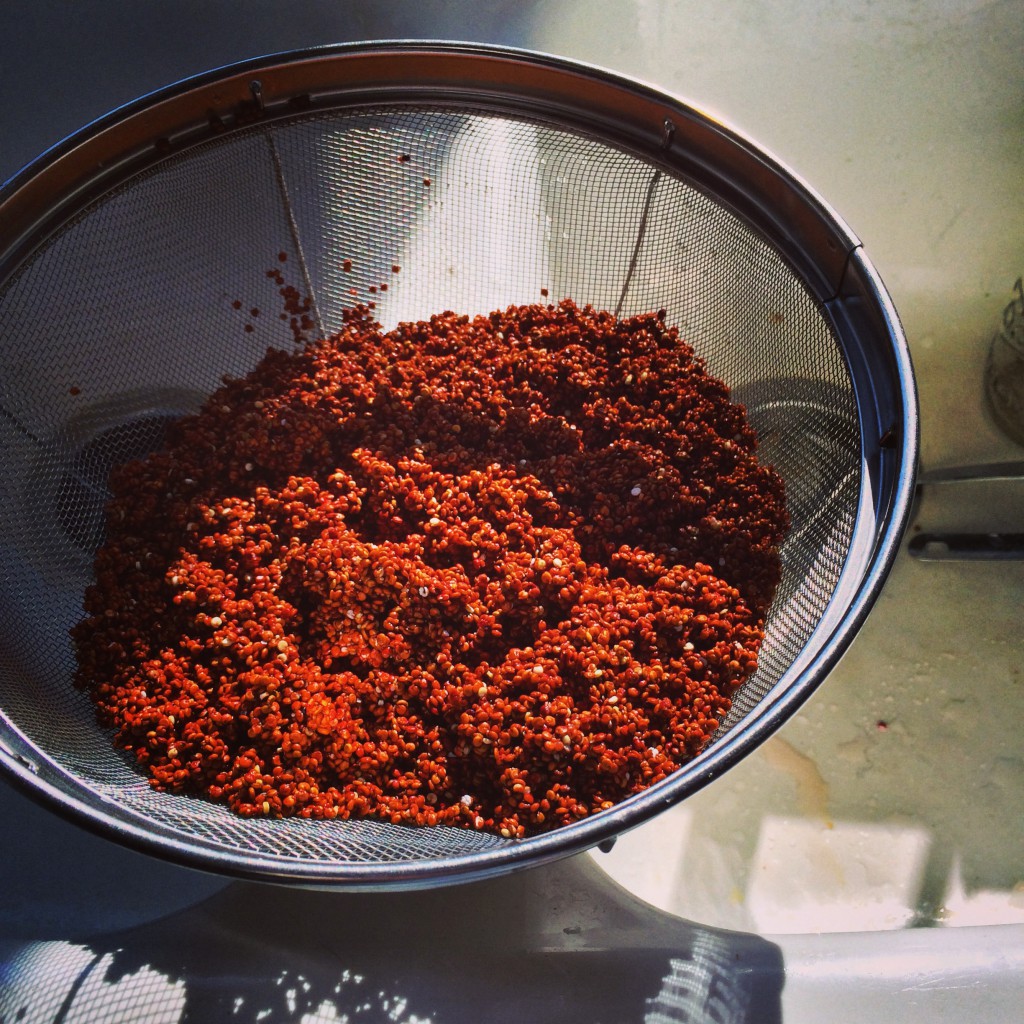
I realize that everything about this dish screams of the current love of all things kale and roasted cauliflower and blah, blah blah with the addition of the ubiquitous quinoa, and more blah, blah, blah coconut water, and where is the creativity or uniqueness in any of that?? You’re right. There isn’t any. Maybe you’ve already done this dish; tossed together a pan of burnished cauliflower with your own uniquely cooked quinoa, and a pan of silky, slowly braised kale that’s pungently scented with garlic and thought that you were a million ways brilliant like I did. There’s nothing to it. And that’s part of why I want to share this delicious and superbly easy dish. There IS nothing to it. Which means you don’t need a whole resume of skills to get a fantastic dinner on the table. Or really, a lot of hands-on time.
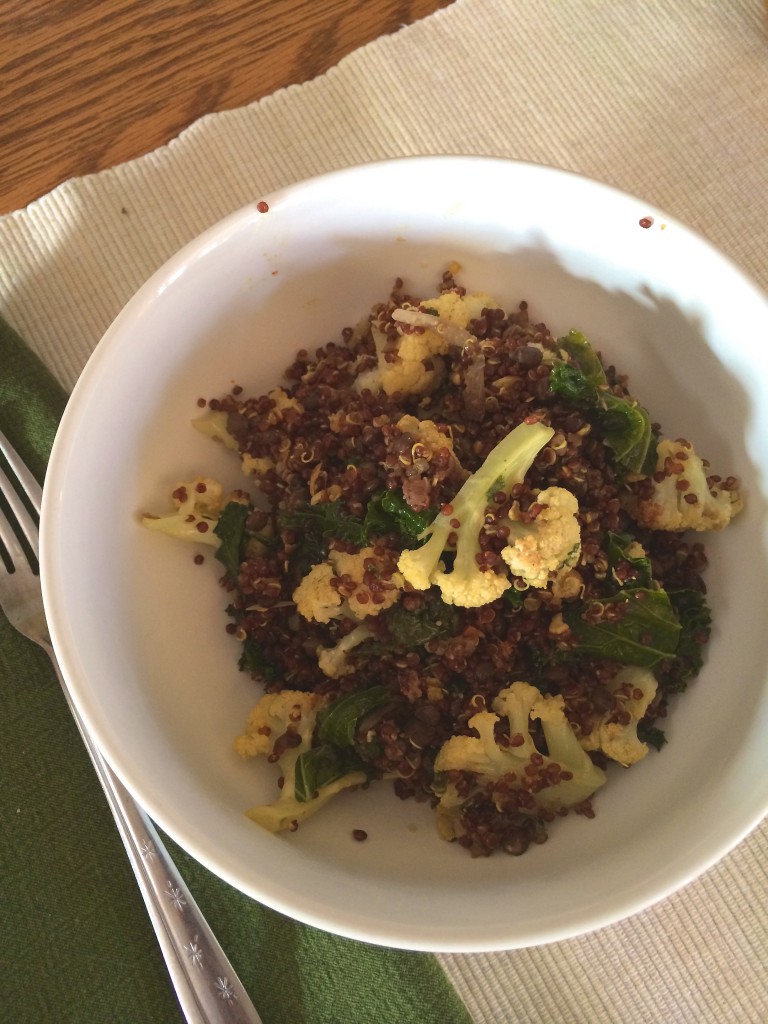
Let’s take that quinoa: it’s one of the simplest grains ever to cook. Forget that whole 2:1 ratio of water to grain, though; with quinoa, it’s wrong, and will result in a mushy, unappetizing food that no one in your house will want to touch. Here’s the deal: one cup of quinoa needs 1-1/4 cups of liquid. That’s it. It needs a simple simmer, and then…. here’s the easiest part; it needs about 15 minutes of you ignoring it on a hot pad when it’s done. Yup. Take it off the heat when the water is absorbed, set it aside, covered, and ignore it. You can ignore it for an hour and it won’t care. In fact, it LOVES to be ignored. You can cook it in the morning and ignore it all day until dinner and it won’t care. Your result, however, will be a toothsome bite to the grain that reveals all of quinoa’s beautiful tastes. Nothing mushy here, folks.
And that kale? Have you ever found curly kale to be tough and chewy? Not to your liking? Try a slow braise of it, on the lowest heat setting your stove will offer, with just a tiny bit of liquid. I promise you this method will render the toughness right out of this nutritional bomb, making it silky, smooth and delicious to eat. Start with a small onion, or shallot, add a few cloves of garlic, then drop the chopped kale in the pan, stir for a few minutes, add enough liquid to cover the bottom of the pan, a pinch of kosher salt, and cover it to cook. You can ignore this one too for a while and it’s ok. Curly kale doesn’t mind. Stir it a few times, and after about 20 minutes or so, the kale will start to show you it’s better side. If it still tastes tough when you sample a leaf, give it more time. Add another pinch of salt, too. It helps break down the cellular walls and tenderize the leaves.
The tender cauliflower, nutty grain and silky kale make for a mouth-awakening dish. And just for fun, I dumped in a bunch of cooked lentils that I had in the fridge to add to all the lip-smacking goodness. This dish…. it’s good when it’s hot; it tastes great at room temperature, and it’s wonderful chilled too. Easy. Endlessly versatile. Colorful. Healthy. It’s got it all. Now YOU need to get it all.
Red Quinoa, Braised Kale & Roasted Cauliflower
1 c. red quinoa, washed well and drained (regular white is fine, too)
1-1/4 c. water (or combination of equal liquids such as coconut water & coconut milk)
1 T. ground turmeric
1 T. smoked paprika
1 bunch curly Kale, washed and de-stemmed
1 medium shallot, minced
2 cloves garlic, minced
1 head Cauliflower, washed and broken in to bite sized pieces.
Salt and pepper to taste.
In a small saucepan, bring water or liquids to a boil. Add the quinoa, turmeric and smoke paprika and stir to combine. Bring to a boil, reduce to simmer, cover and allow to cook until the liquid has been absorbed. Keep covered, remove from heat and set aside for at least 15 minutes, or up to several hours. No need to chill. Fluff the grains before utilizing.
Meanwhile, heat your oven to 400°. Place cauliflower on a baking sheet and drizzle with a bit of olive oil and a sprinkle of kosher salt. Mix well and place in hot oven. Stir occasionally and roast until fork-tender and browned in spots.
In a medium skillet, heat a small amount of oil and sear the shallot and garlic until tender and slightly browned. Add the kale and stir until coated. Pour about 1/3 cup of water in the pan, sprinkle a pinch of kosher salt on the kale and stir to combine. Cover the pan, reduce to the lowest heat setting and allow to cook, stirring once or twice, for 20-25 minutes. Taste a kale leaf; if it still tastes chewy, cook for 5-10 more minutes. The kale should be silky and tender in your teeth. Keep the heat LOW.
Combine the quinoa, cauliflower and kale in a large bowl and taste for seasoning, adding more salt or pepper if desired.
{NOTE: I don’t include cooking times for this recipe, or any of mine really, because your oven and stovetop is not the same as mine. Instinct, as a cook, is a necessity; your browned cauliflower might look different than mine. Your onions could cook quicker, and your Low setting on your stove could be higher than mine and cook that kale faster. Trust. Taste as you go. And trust some more. Your mouth will tell you when it’s done.}
March 17th, 2014
| 2 Comments »
Just 10 days ago, I underwent LASIK eye surgery and my life shifted in ways that I’m still learning to understand. I’m trying to make sense of it all, but only those who’ve been under the burden of eyeglasses for their entire life, then freed from the need in a quick, 7 minute procedure would be able to know why this is such a huge, life-changing shift.
So for the rest of you, I’ll just talk about pasta. Because that’s just not that big of a deal, right? But this dish I created recently, well, this IS a big deal.
I’ve been pasta-less most of the past year, and not for the standard ‘I’m carb-free’ or ‘I don’t DO pasta’ whine whine that this basic staple is devil spawn. We went through a long period where pasta was standard in our dinner repertoire, and I just became tired of it. Then, lately, there’s been that nagging sense that something was causing pure belly sadness and pasta, being cloaked in wheat, was ignored. Finally, I realized that I missed a steaming bowl of carb goodness. It was March in Minnesota, after all. Enough said.
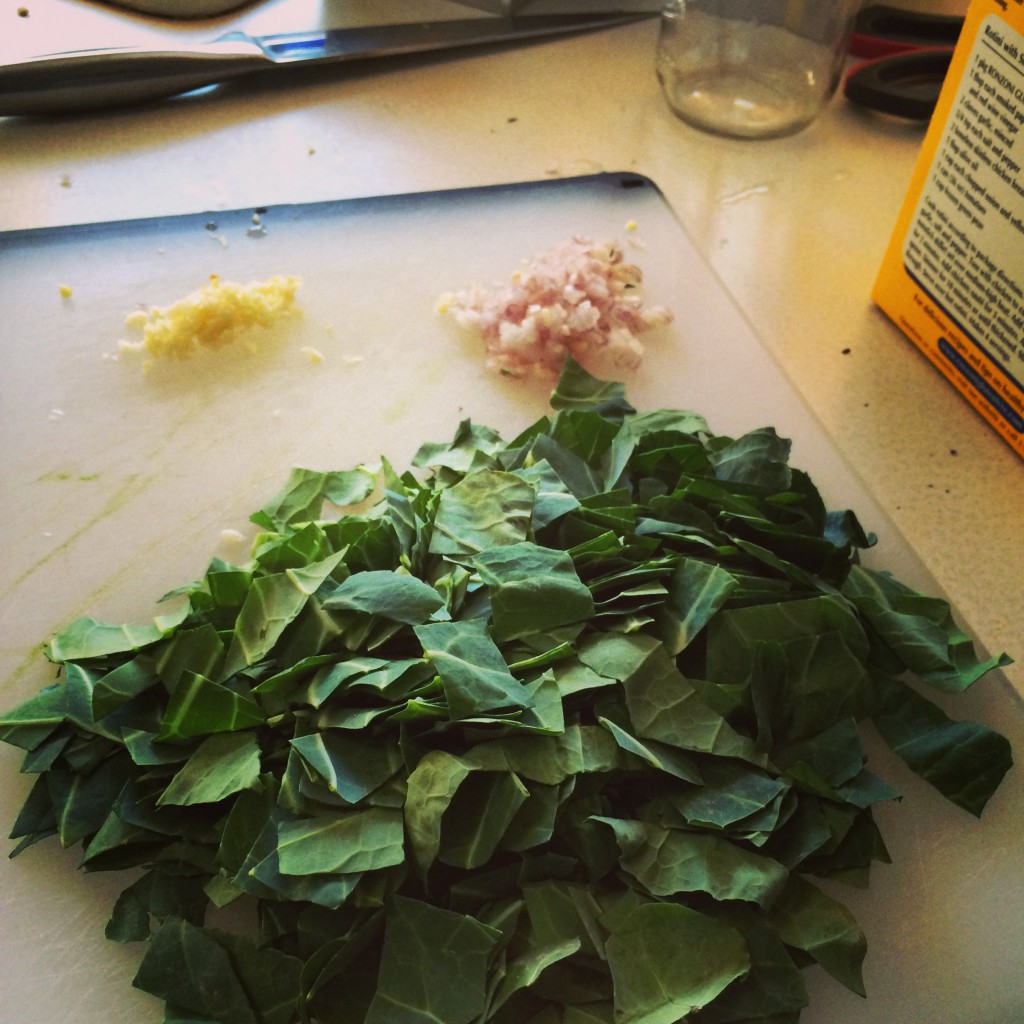
After the first few days post-LASIK, where my eyes felt like being perpetually stuck behind dirty contacts, hazy edges of everything and light that nearly pierced my brain in it’s brightness, I hadn’t experimented with just how my new means of vision would translate in the kitchen, and my need to clearly see my hands. Mike had brought home a box of gluten-free pasta that promised in large, persuasive text that it had a ‘White Pasta Taste!’ and my family would never know the difference. I craved a bowl of buttery noodles, covered in a thin layer of shaved parmesan, a salve for the body that was now rendered off in a new direction, brain and eyes communicating after a lifetime of silence. Everything was new. And I needed something old and familiar.
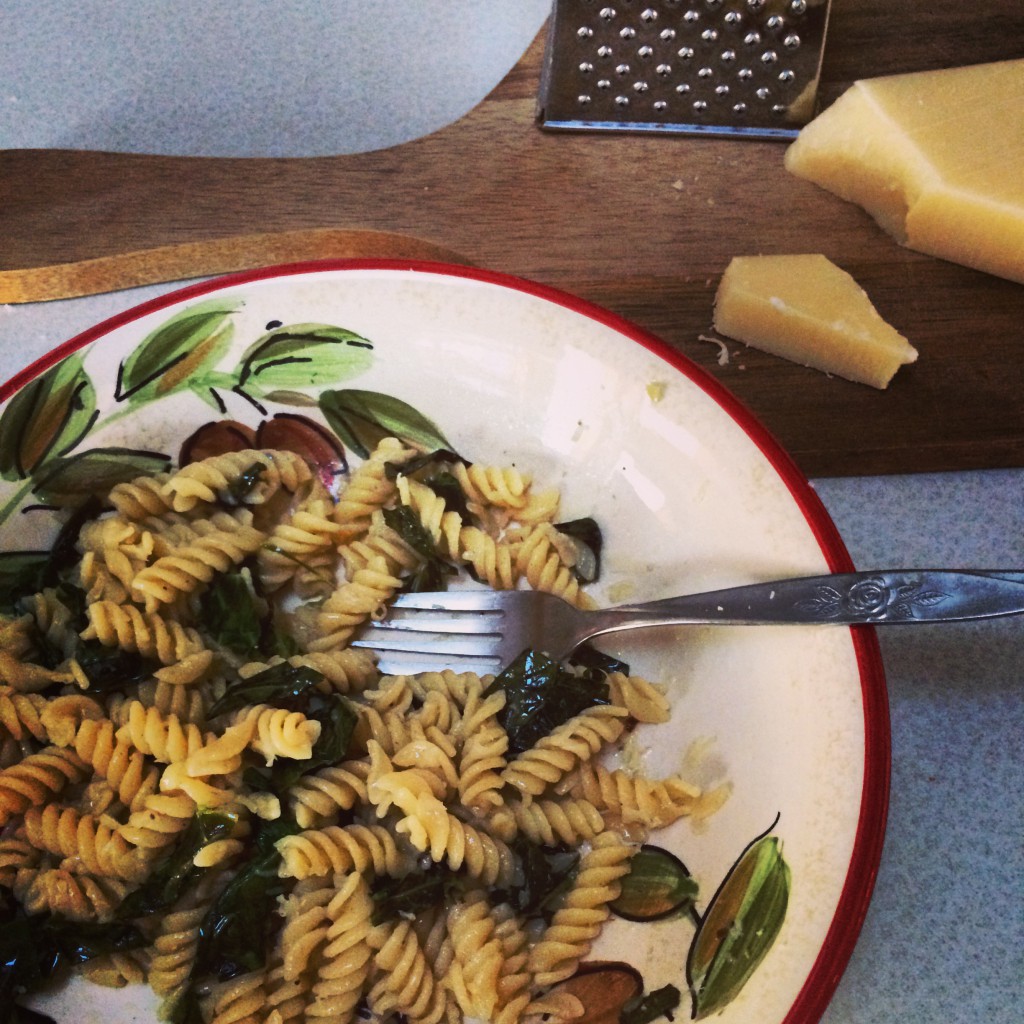
But this dish turned out to be anything but, yet, at the same time, it soothed immensely. It was buttery noodles. There was lots of fresh shaved parmesan cheese, just as I desired. But there were sautéed collard greens, a deeply burnished bed of shallots and garlic, and all of it was bathed in the deep umami of a thick anchovy fillet, melted in a puddle of olive oil. Skipping over the familiar, I added a dose of the here and now, trying to pull together two sides of my life that were now in conflict inside my head. I wish I could explain it better than that, but there’s so much to comprehend from this simple procedure that I never anticipated, so much emotion- being able to read the labels on the bottles in my shower, seeing the texture of the ceiling when I awake, pressing my cheek to my husband’s without the pinch of eyeglasses between us- the simplest of life moments that so many take for granted and never think about that suddenly are part of my life. I’m close to weeping every day at this wonderful, unfamiliar and amazing world. I can’t wait to leap in to a lake or pool this summer and come up with clear vision. I may break down crying at how great that will feel.
My boy wandered in the kitchen, dressed for his Wednesday night youth group at church and stuck his nose in the pot of pasta I was stirring together, clinging to thin sheets of collards and tiny chunks of allium, steam rising from the glistening spirals. His eyebrows rose in anticipation and he drew two forks from the drawer, and together we stuck a few noodles to the tines and lifted them to our mouths. I shaved the parm on his bowl, then mine, and we bent our elbows to the island in our kitchen, shoulder to shoulder and dipped our forks. This act of simple consumption with he and I is a need for both of us, to connect over a bowl of modest food, leaning together in companionable silence except for the clink of silverware, a swift moment to just be. It added to the familiar that my brain was seeking. He sighed as he scooped up the last noodle, moving it around the bowl to grab the last drops of oil and butter, the remaining bits of cheese. He smiled at me and leaned his shoulder in to mine, his gesture of thanks well received, another wave of the familiar among a week of new discoveries.
This pasta was so good; simple, deeply flavorful and crazy easy to make. If you haven’t experimented with anchovies in pasta dishes, I urge you to just try it, as they add immense depth.
Pasta with Collard Greens and Anchovy
1# pasta, cooked
1 thick bunch Collard Greens, stems removed, washed and rough chopped
1 medium shallot
2 cloves garlic
1 Anchovy fillet (or two, depending on size; I used Wild Planet White Anchovies, and they are BIG)
Butter and olive oil for cooking.
Parmesan cheese to taste
Cook pasta according to personal taste. While the pasta is cooking, heat a large, deep skillet and add a knob of good butter, along with a drizzle of olive oil. Sauté the shallot and garlic, stirring frequently, until golden in color. Add the anchovy fillet and mash with a spoon to break it up. Stir in the collard greens to coat, add about 1/4 cup of water, then cover the pan and reduce the heat to medium-low. Cook until the collards are soft, but still retain some texture.
Drain pasta, reserving a small amount of liquid. Add pasta to pot with collards and stir well to combine. Grind some black pepper over it, along with a few shakes of sea salt, stir some more and taste for seasoning. Adjust if you like. Add another drizzle of olive oil, or some more butter if you prefer, or some of the pasta water if it seems too dry. Spoon in to serving bowls and top with shaved parmesan cheese to taste. Grab a fork, and someone you love.
January 8th, 2014
| 2 Comments »
We’re on the upswing of some pretty intensely cold weather. Thankfully it was brief, only a few days, but the deep freeze shut down the state in ways that I haven’t seen in almost 20 years.
I’m old enough to well recall the last two deep freeze spells that came through Minnesota; the last one, in 1996 caught me inside a superbly drafty, old house and my poor baby, barely even 2 years old, was wrapped up so tight in layers that he could barely toddle around. We spent a lot of time snuggled in blankets watching PBS and reading books. And prior to that, in 1994, I was carrying him around on my insides, and so toasty warm with extra weight and hormones that I walked to the bus stop in -20 temperatures, with a cruel wind to boot, in an open winter coat that flapped in that vicious breeze. And I was still too warm. I didn’t get any frostbite, but I sure got some weird looks.
And here’s the thing; yes, by golly, it’s cold. But that just means more layers, more awareness when going out. I was outside on both of our recent cold days and although I could certainly vouch for the bone-chilling wind, I was dressed properly and felt just fine. Not fine enough for being out very long, taking a walk or getting out the nordic skis, but there was no fear in running errands and going about my business. Working in a grocery store led me to witness some pretty bizarre behaviors in people buying up supplies like an apocalypse was upon us, but quite frankly, I’m more fearful of being out in a blizzard than I am of dealing with a polar vortex. Cold is not so bad if you aren’t afraid of it.
We did have a big hiccup with Mike’s car, though, as he willingly allowed Griffin to park his car in our garage overnight so that when he had to leave for work at 4:30am, his car might start a bit easier. Which it did. But, as you can imagine, Mike’s car wouldn’t start after being out overnight in -50 wind chills. After multiple attempts to get the engine running, he disconnected the battery and brought it inside to warm up, keeping it connected to an electric charger. The next morning, the car roared to life as it should. Bottom line: if your car has to be outside, try taking the battery inside on those brutal nights. It’s a little extra work that might save you from a dead vehicle. And an electric charger should be in everyone’s arsenal.
Our fireplace got a lot of use over the past week, too. It’s gas, which isn’t our favorite, but you can’t beat it for ease and for incredible warmth. The fireplace has a blower that sends the warm, heated air out in to the room, and I curl up on the sofa in front of it, cats draped across my lap, my knitting in hand and a movie or TV show on Netflix and can pretty much forget that’s it’s not a fit night for anyone outside our windows.
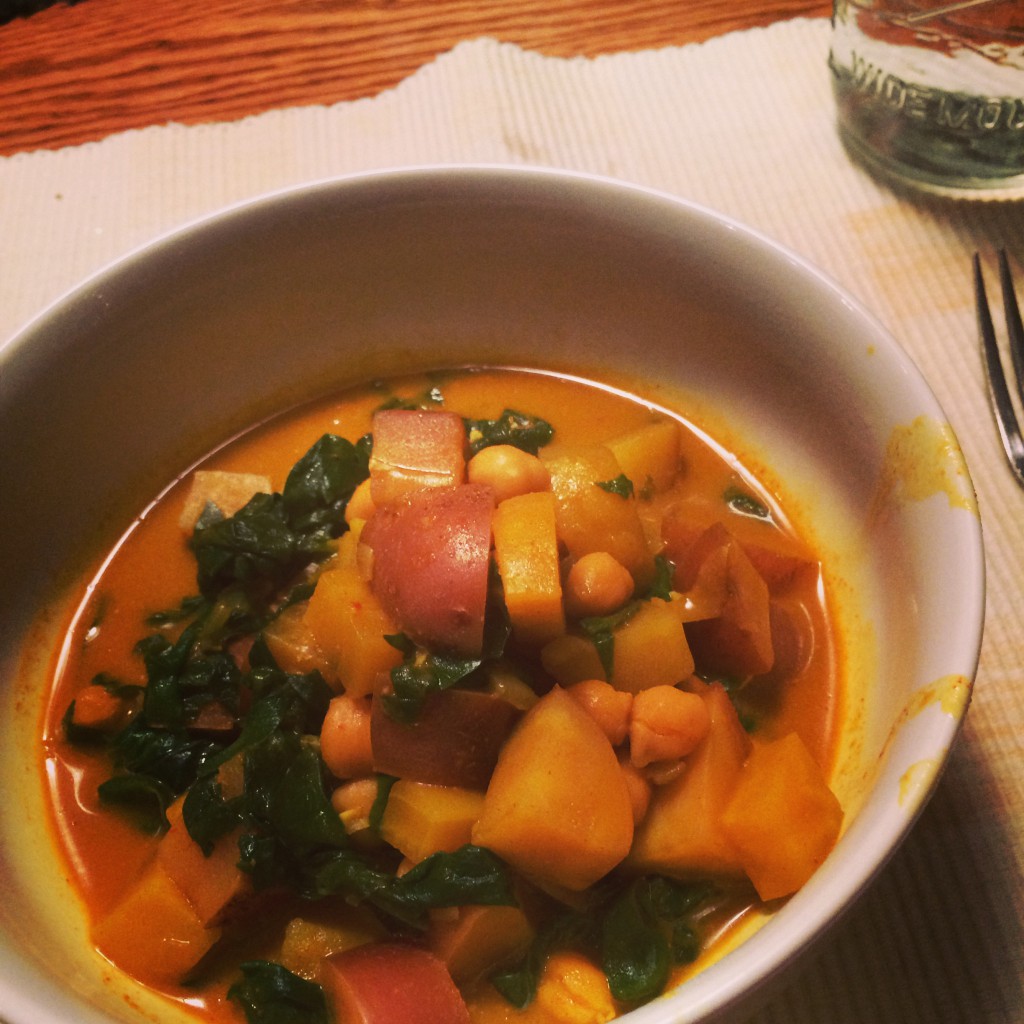
At the top of every coping mechanism, however, is the food we love to consume when the weather bottoms out. You all know that I love soup, almost beyond words, and for one of our bitterly cold night, I made a simple pot of simmered beet greens, chickpeas and red-skinned potatoes from our Fall Storage CSA share. Simmered in turmeric-laced coconut milk, spiked with red curry paste, it was enough to cut through even the most bone-rattling cold, warming us right to our toes. Beet greens {and all hearty greens, like kale, mustard greens, collard greens, and chard) become silky smooth, nearly melting in your mouth when simmered slowly, and this method has made me a huge fan of just about any dark, leafy green, loaded with the iron our bodies need. This soup is pretty similar to my popular Braised Kale & Chickpeas recipe, with a few tweaks here and there. The addition of turmeric adds lovely color, and the wonderful anti-inflammatory properties that turmeric offers.
We’re expected to warm up in to the low 30’s by the weekend, and I can’t even imagine how delightful that’s going to feel after this last blast of arctic air, but, sadly, weather patterns hint at the brutal cold returning all too soon. There’s lots of Winter left. Plenty of soup to be made, I imagine.
Greens, Potatoes & Chickpeas in Coconut Milk
1 large bunch dark, leafy greens such as Beet, Collard, Chard or Kale, washed, de-stemmed & rough chopped
1/2# red-skinned potatoes, scrubbed and cut to 1/2″ {leave the peels on}
2 c. cooked chickpeas {equal to 1 15-oz can, rinsed well}
1 15-oz can coconut milk {use full fat for best flavor}
1 c. water
2 T. ground turmeric
2 T. red curry paste {optional, but you’ll love how it warms you from the inside}
1 large shallot, minced
3 cloves garlic, minced {use less, or more, to taste}
In a deep skillet, warm oil of choice and sauté the shallot and garlic with a big pinch of salt until softened, about 5 minutes.
Add in the greens by the handful, stirring to help them wilt slightly. When all the greens are added, pour in the coconut milk and water, and stir to combine. You won’t have a ton of broth, and you don’t need a lot. Add the curry paste and whisk to incorporate, then sprinkle the turmeric over everything and stir until combined. Bring to a simmer, add the potatoes and chickpeas, then cover and cook over low heat until the potatoes are just fork tender, stirring occasionally. Don’t cook them to the point of falling apart. The greens should be silky smooth.
Season to your taste with salt and pepper, then ladle in to bowls.
December 31st, 2013
| Comments Off on cold weather coping, with Vegetable Shepherds Pie
There’s no shortage of weather folklore to be found, in which the rhythm of the seasons can be a harbinger for predicting coming temperatures. This one seemed particularly fitting to our current weather in Minnesota.
When leaves fall early, Fall and Winter will be mild;
When leaves fall late, Winter will be severe.
Our whole theater of seasons in Minnesota was far, far behind the norm this year, with snow falling on May 1st, the growing season extended to near the end of October, and Autumn leaves peaking weeks behind schedule. Is it all an indication that our Winter will continue to be caught in a deep freeze? Stick around.
Decembers as of late have been all across the board for weather; we’ve had monster blizzards (December ’10) that dumped nearly 2-1/2 feet of snow on us, and Christmas weeks that have had nothing but hard rain (December ’12).
This December, it’s been the season of sub-zero temperatures.
It’s a languid post-Christmas week (languid for me as I took 9 days off after Christmas), and we’re already experiencing a second round of deep cold and unpleasant wind chills, of complaining and groaning over why one lives in such a place, running through Instagram photos of island vacations past, to dream of warm sand and sunshine and forget that exposed skin could acquire frostbite in just 10 minutes exposure outside. We bake to ward off the chill, simmer kettles of soup or slowly braise a comforting pot, cuddle under blankets, binge-watch Netflix and Hulu or movie catalogs, or just plain deal with it when the temperatures plummet and the wind bites with gnashing teeth at our skin. But one thing remains; we’re all in this together.
Cold weather isn’t much of an issue with me. I’ll add another layer, pull out the thick, warm wool mittens, tug on some leg warmers and keep my head down from the wind. Inside, I slip on wooly hand warmers, sheepskin slippers and invite the cats for a snuggle. Cranking up the oven helps too, as adding warm, cozy foods to the menu is the best way to keep warm from the inside.
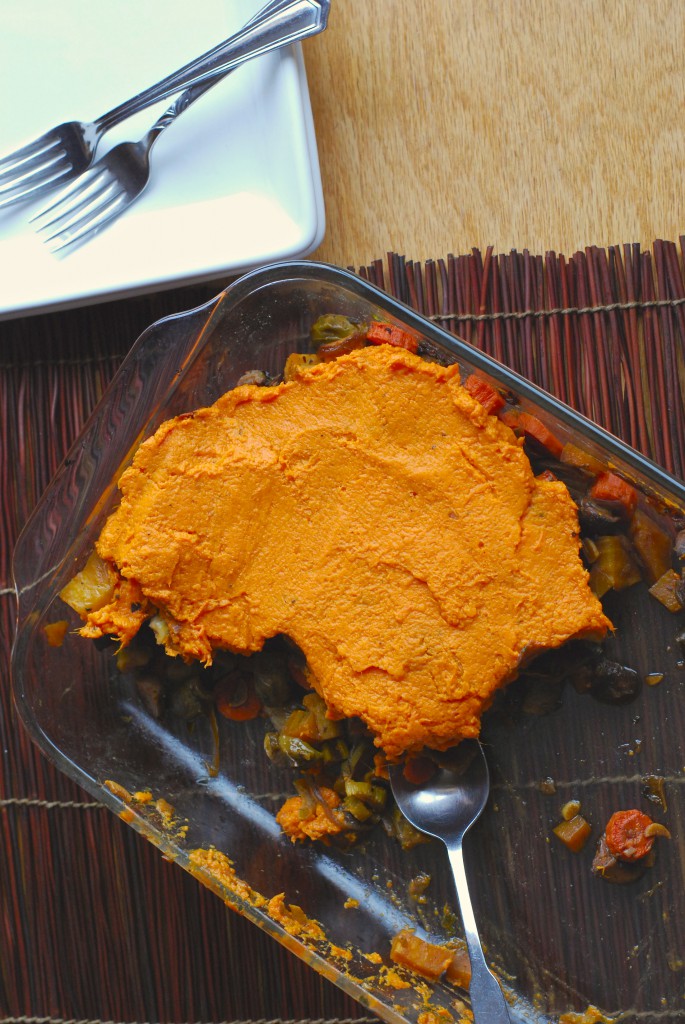
This Vegetable Shepherd’s Pie was created as a vegetarian entree I was designated to bring for a Christmas gathering with my in-laws. I wanted something that would be universally accepted across the board by all the various dietary needs of our extended family; the Primal eaters, the wheat-free, the dairy-free and the meatless. It covers all those bases with it’s lush pile of heavenly roasted vegetables bathed in a balsamic glaze and a simple shower of salt and pepper. I chose not to use a binder to hold it all together, and instead of rich, buttery potatoes coating the top, I used roasted sweet potatoes, spun to a silken mass with a hand-mixer, touched only with good seasonings. The result was remarkable in flavor, eye-catching in presentation. I was thankful that it was so well-received, and grateful to have still a large portion to bring home and consume, post Christmas, as the deep cold set in.
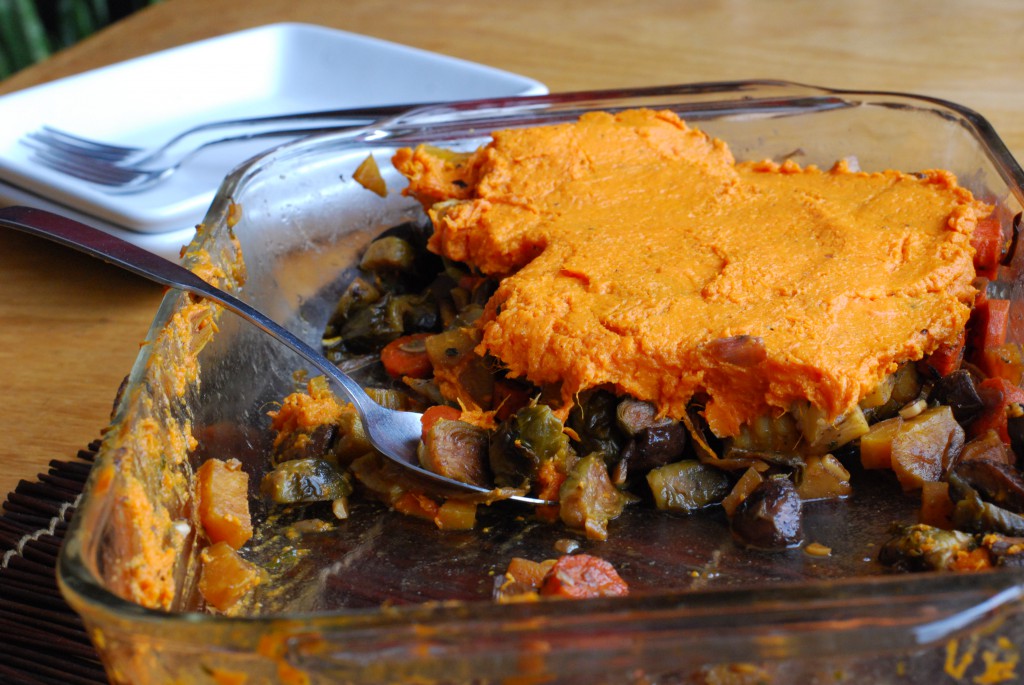
Don’t be put off by the long recipe; you roast most of the vegetables, which can be accomplished while the sweet potatoes and beets do their thing in a hot oven. You’ll spend some time prepping those veggies, but putting it all together happens quickly. You can make the recipe in two 8×8 pans, saving one in the freezer for another time. Another elegant presentation would be to portion out ramekins for individual servings, an ultimate dinner party delight. The recipe makes plenty of filling to do with as your creativity leads you.
Best of all, when the temperatures drop and your belly growls it’s hunger at you, this feeds you with warmth, good health and well-being. For the upcoming winter, you’ll love having this in your repertoire.
Vegetable Shepherd’s Pie
3 Parsnips, peeled, cut to 1/2” chunks
4 medium carrots, peeled, cut to 1/2” chunks
2 stalks celery, cut to 1/2” pieces
2 8-oz pkgs whole baby portabella mushrooms, quartered
1 medium onion, halved, sliced thin
4 cloves garlic, peeled and rough chopped
3 cups Brussels Sprouts, trimmed and halved
4 small to medium gold beets (from one bunch) scrubbed, greens removed if needed
5 medium sweet potatoes, scrubbed well
1/3 c. mixed fresh herbs, minced (oregano, parsley and thyme are delicious)
olive oil
salt and pepper
balsamic vinegar
Heat oven to 400 degrees. You will be roasting all of the vegetables except for the celery, onion, mushroom and garlic. They will all take different amounts of time to finish, so start with the ones that will take the longest: poke the sweet potatoes a few times with a sharp knife and place on a foil lined baking sheet. Wrap beets well in foil. Place both in hot oven and roast until tender. A fork should slip easily in to the beets when they are done. Set aside to cool.
In a bowl, toss parsnips with a bit of olive oil and salt and scrape onto one side of a baking sheet. Repeat with carrots, and place on the other side of the baking sheet. Roast in hot oven until just tender. Place back in bowl and set aside. Repeat with Brussels sprouts, roasting until just tender. Scrape from pan in to bowl with parsnips and carrots.
Meanwhile, in a large, deep skillet, warm 2 tablespoons of olive oil and 2 tablespoons butter. When bubbling, add mushrooms, and sauté over medium-high heat, stirring regularly, until they release their liquid. Add onion and celery and continue to cook, stirring often, until they soften, about 5 minutes. Reduce heat slightly, and cook for about 10 minutes, allowing the mushrooms to brown in spots and become very fragrant. Stir in garlic and sauté for about a minute, then add about 1/3 cup of balsamic vinegar. Scrape up any browned bits in the skillet, and simmer until the vinegar is absorbed. Add in the parsnips, carrots, and brussels sprouts and 1/4 cup balsamic vinegar. Stir to combine and allow to simmer over low heat for a few minutes. Turn off the heat. Peel the beets, chop in to bite sized pieces and stir in to vegetable mix with the fresh herbs. Scrape entire pan in to a 9×13 baking dish.
Peel sweet potatoes and place in a bowl. Mash with a fork, or potato masher until smooth and creamy, season with salt and pepper. Spread evenly over vegetables. Place back in the oven for 15-20 minutes to heat through.
October 16th, 2013
| 1 Comment »
October is a great month for many good happenings in the kitchen, like baking, and soup simmering, and fragrant dishes of all kinds, but THIS October is different as I’m in the midst of a 3-week detox, with many a limitation on what I’m eating. I’m hoping it helps to re-set some health issues I’ve been having, and support more consistent sleep patterns.
It isn’t all bad. I’m actually allowed a lot of delicious foods and I’m never hungry, but I’m wishing I could make pumpkin bread and eat a thick slice dredged in good butter. I’ll be celebrating Halloween by doing just that.
Until then…..
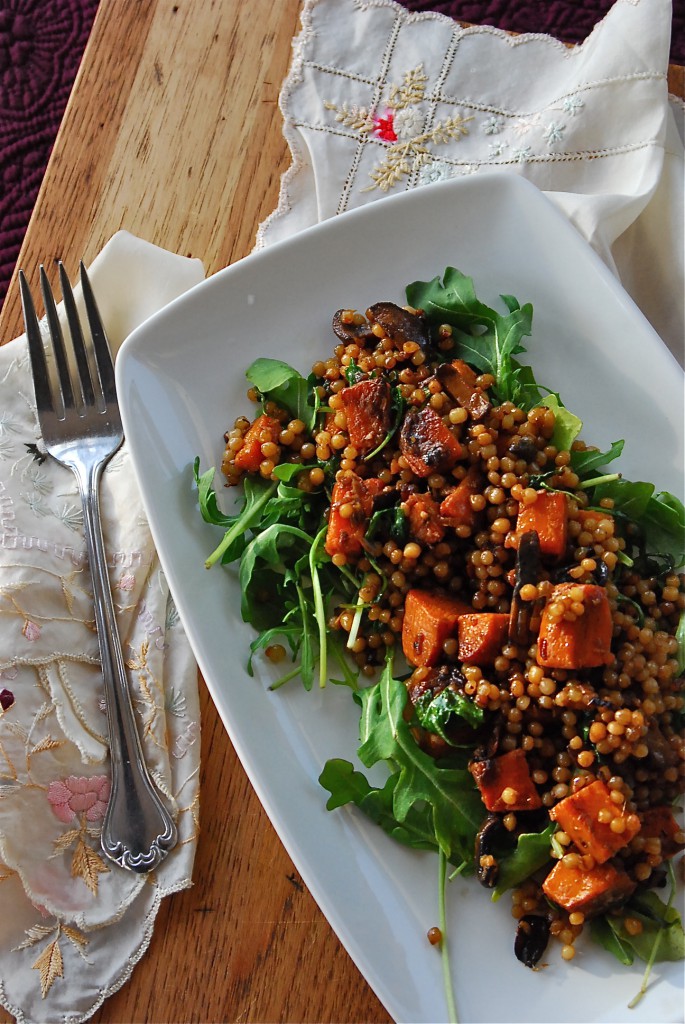
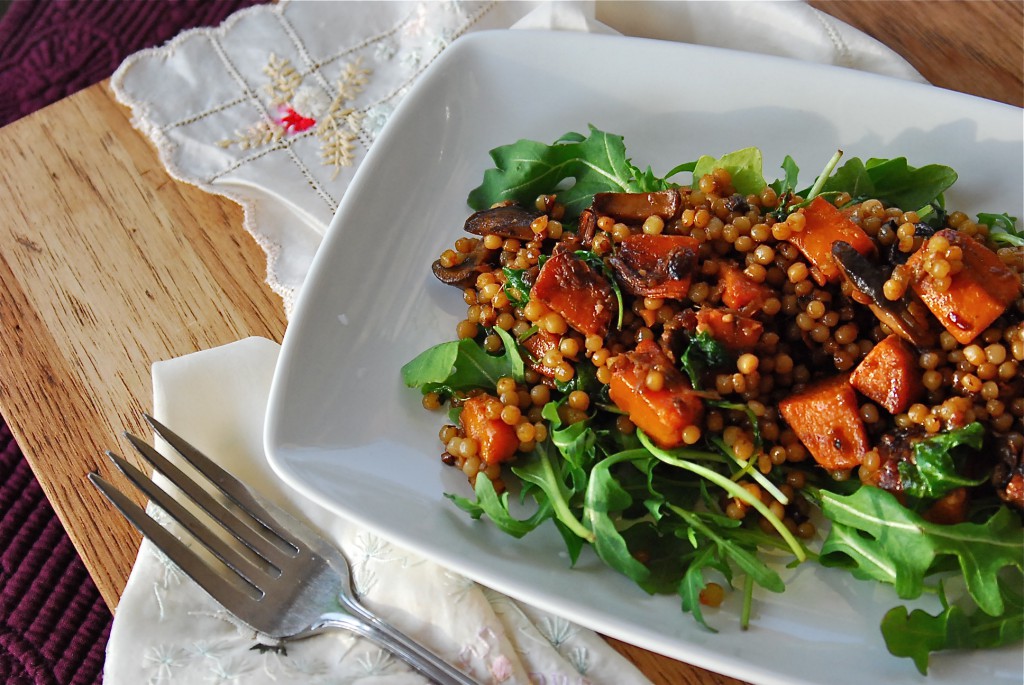
This recipe is so perfect for right now. We’re being drenched in Autumn rain and it’s become quite gloomy outside. Fall color has it’s own beauty against the dull and gray rainclouds, though, and inside your kitchen, this dish can bring a blaze of burnished color to a chilly and uninspiring day.
I first made this dish last Winter and we absolutely fell in love with it. While it does take a bit of work, the flavor is compelling, and well worth a bit of time. Pour a glass of good wine, or a delicious craft beer and sip while you cook, stir and inhale.
Caramelized Vegetables with Pearl Couscous
Salt
2 c. pearl couscous
Grapeseed, or coconut oil
1 large sweet potato (about 3/4 pound), peeled and diced, about 1/4″-1/2″
1 large onion (about 1 pound), finely diced
4 cloves garlic, minced
3-inch piece fresh ginger — peeled and chopped fine, about 1 tablespoon
1-8oz pkg portabella mushrooms, sliced, with stems removed
1 T. balsamic vinegar
2 T. soy sauce
3 big leaves chard or kale, stalks removed and leaves finely chopped — about 2 cups (I subbed in the equivalent of arugula)
Freshly ground black pepper
Parmesan, optional
Heat a large pot of water to boiling and salt it generously. Cook the couscous until barely al dente — about 5 minutes. Drain and toss with a generous drizzle of oil so that the grains are lightly coated with oil. Set aside.
Heat a large sauté or frying pan (the largest you have — you want plenty of room and hot surface) over high heat. Drizzle in a little grapeseed or coconut oil (not olive oil — you want an oil with a high smoke point) and heat until very hot. Add the sweet potatoes and arrange them in one layer. Cook them over high heat until they are beginning to caramelize and turn brown — about 4 minutes. Flip them over and cook for another 3 minutes or so.
Turn the heat down to medium and add the onions, sprinkling them with about a teaspoon of salt. Cook, stirring occasionally, until the onions are beginning to turn brown. Add the minced garlic and chopped ginger and stir them into the onions. Push the sweet potato and onions to the edges of the pan, making room in the center.
Add the sliced portabella mushrooms to the hot center of the pan and cook them for 4 minutes without turning them. Then flip and stir them and cook for another 4 minutes. Once browned, stir them in to the sweet potato and onions. Keep the heat at medium, or slightly higher. Stir the vegetables occasionally. You want them richly browned.
At this point everything should be getting well-cooked; the onions should be quite dark brown and the garlic should be golden and soft. The potatoes should be softening.
Whisk together the vinegar, soy sauce, and 2 tablespoons of oil. Pour this into the pan with the vegetables and mix everything together, scraping the bottom as you go. Cook all the elements together for about 3 minutes on medium heat. Then turn the heat up to high, as high as it will go.
Add the couscous gradually, shaking in about a cup at a time, stirring and scraping constantly. Cook the couscous over high heat with the rest of the vegetables for about 5 minutes, letting the couscous get browned on the bottom of the pan, then scraping it up. You are developing a little more color and flavor on the pasta, and helping all the flavors combine. (I cooked this a bit longer to get more flavor in the couscous. The browning of it smells glorious)
Finally, toss the greens into the mix and cook for 1 more minute or until the greens are barely wilted. Turn off the heat and taste. Add salt and pepper if needed. Serve hot, with shavings of Parmesan if desired. (We didn’t even consider the parmesan. And I don’t think it even needed it.)
October 9th, 2013
| 1 Comment »
I love October. I love everything about it, from it’s blazing maples and fiery Sumac to the clear, crisp nights of abundant stars, the scent of woodsmoke floating on the chilled air. I love that switch to snugglier clothes and another blanket on the bed. I love a simmering soup pot, a pan of fragrant cornbread, baking with apples and fresh-pressed, rich apple cider
I just LOVE October!
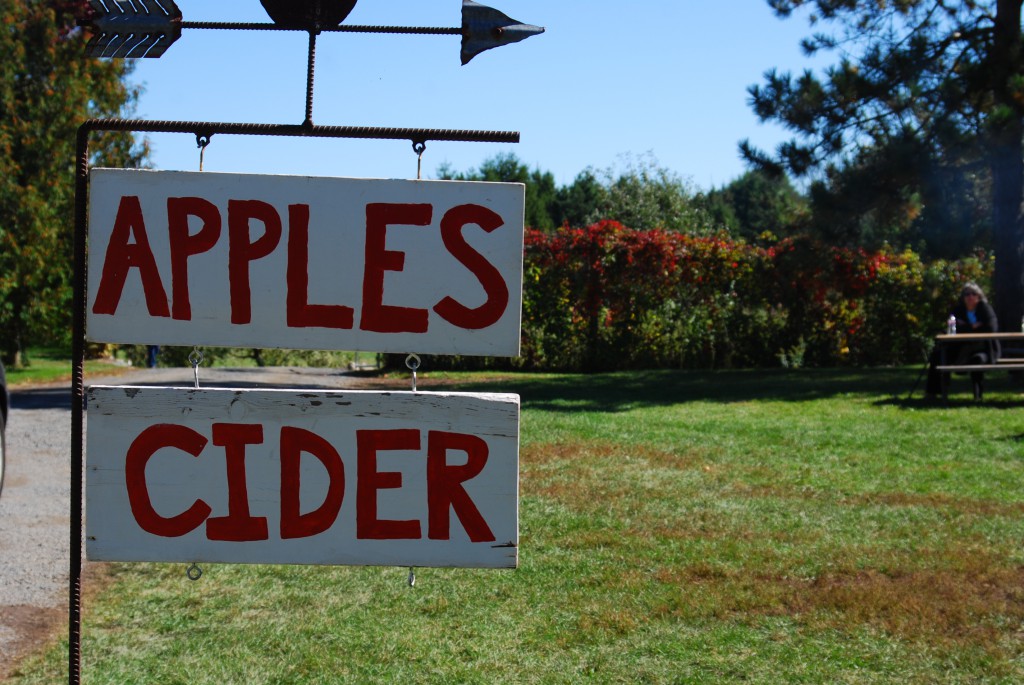
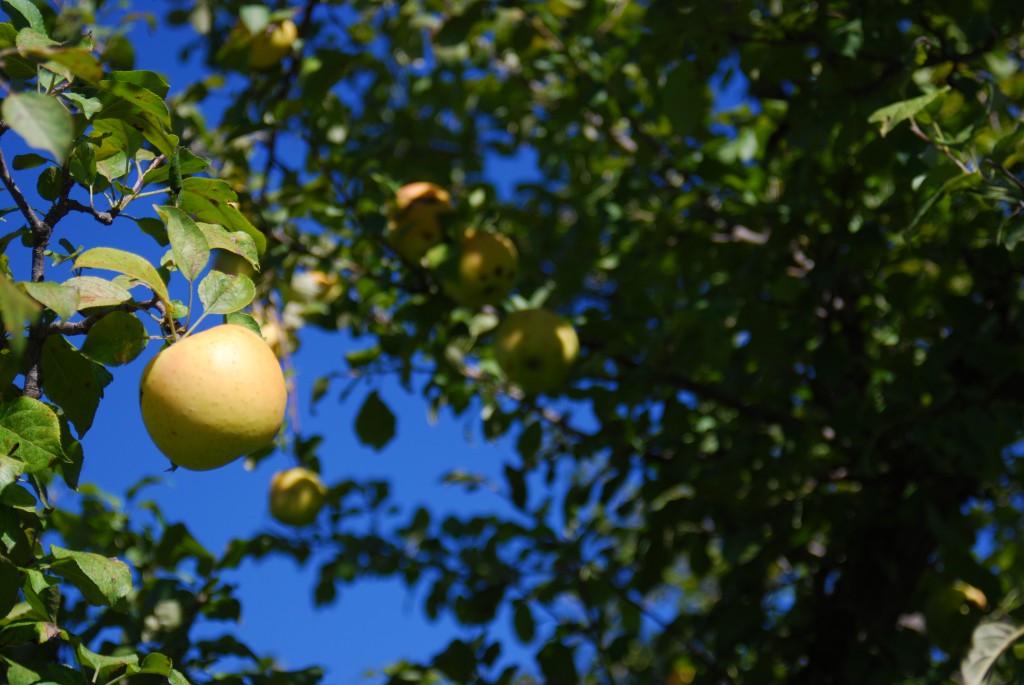
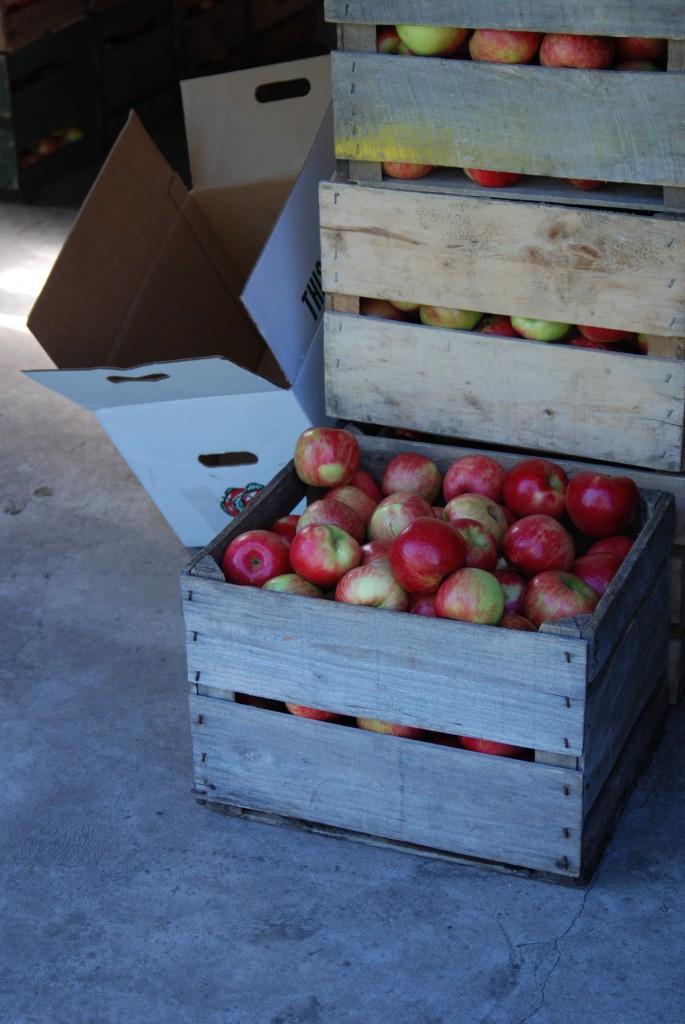


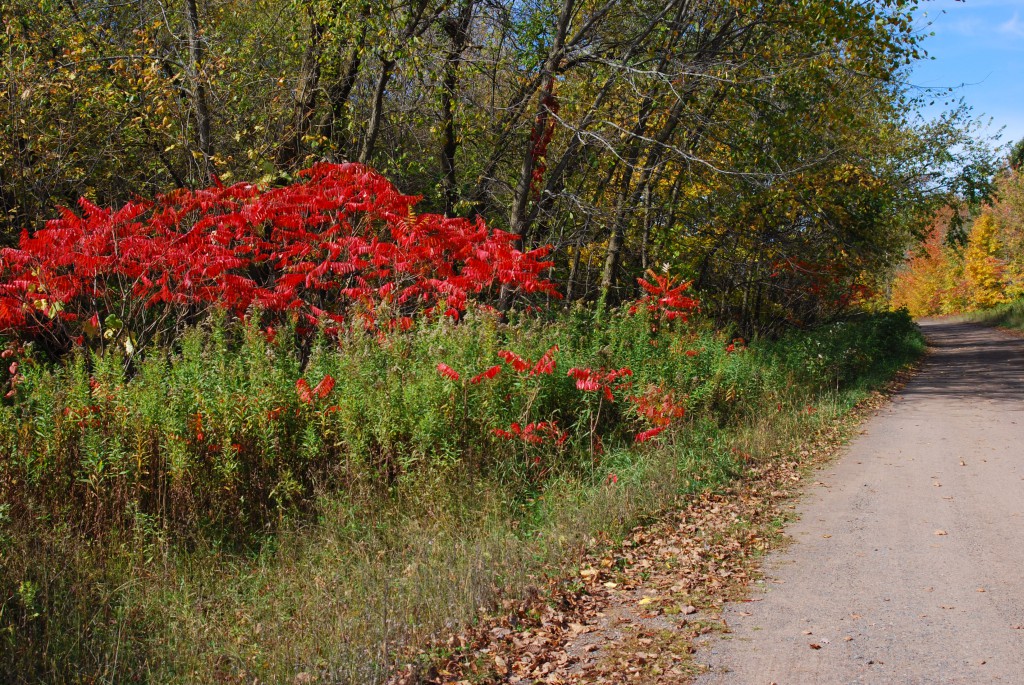

I haven’t always loved Ratatouille, though. And I’ve made it multiple ways that have been OK, to an extent, but haven’t been so wonderful that I jumped at a chance to repeat the recipe. Yet every year, when the abundance of zucchini and eggplant and tomato is all there, ready and waiting to be slowly cooked together in this classic peasant dish, I always want to try something again.
There are so many ways to make a simple dish like this.
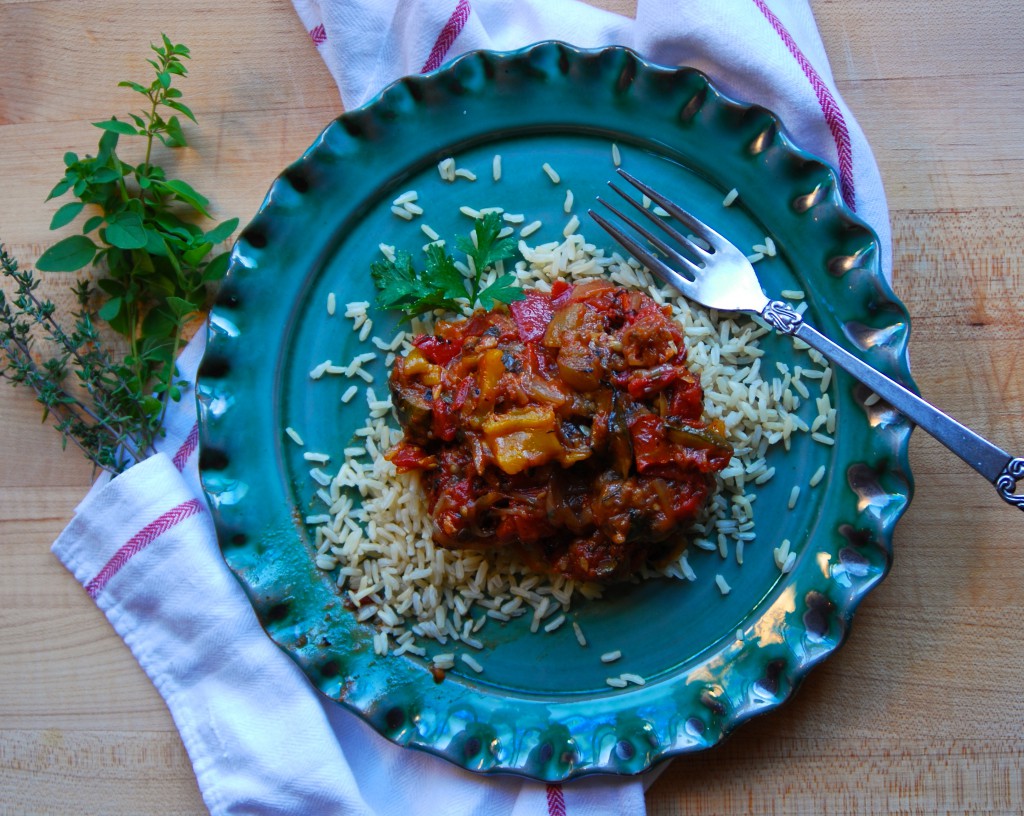
This recipe I would repeat. Over and over again. While it is a bit extensive, with the grilling and the simmering, the end result is well worth the extra effort. This Ratatouille was silky smooth and simply melted in my mouth, with hints of smokiness from the grill. And as all good dishes go, it was even better the next day.
This recipe does not use fresh tomatoes, and I love the rich flavor that fire-roasted canned tomatoes gives it. Feel free to use fresh if you wish, knowing you will lose some of that smoky taste if you do.
Ratatouille, Grilled and Simmered
3 small zucchini, sliced horizontally
1 medium eggplant, peeled and sliced into 1/2″ slices
2 medium onions, sliced thin
3 cloves garlic, finely minced
1 each red, yellow and orange bell pepper, gutted and halved
1 28-oz can fire roasted tomatoes (strongly suggested for the amazing flavor they will add- sub in fresh if you wish)
1/2 c. good quality olive oil
1/4 c. balsamic vinegar
1/4 c. mixed fresh herbs, like oregano, thyme, parsley, basil, all finely minced
2 t. smoked paprika (smoked is preferred; use regular if it’s all you have)
Salt and pepper
Whisk the olive oil and balsamic vinegar together in a measuring cup. Brush a small amount on one side of the eggplant slices, being careful not to spread on too much. Brush some on the zucchini and reserve the remaining oil/vinegar mix for later.
In a 6-qt stockpot, heat a small drizzle of olive oil and add the sliced onions. Cook over medium heat, stirring occasionally, until the onions are opaque. Add the garlic, reduce the heat and cook, stirring often, until the onions and garlic are very soft.
While the onions cook, heat your grill, and when hot, place the peppers, skin side down on the hottest part. Add the sliced zucchini and eggplant, and cook until tender and slightly charred for all vegetables. Place peppers in a bowl and cover with plastic wrap to steam so you can remove the skin. Rough chop the zucchini and eggplant and add to the pan with the onions, stirring to combine. Drizzle in a small amount of the oil/vinegar mix to moisten and add the smoked paprika. When cool enough to handle, skin the peppers and rough chop those, adding to the pan, along with the can of tomatoes. Stir everything, get it simmering, then reduce the heat and cover the pan. Allow it to cook, slowly, for 30 minutes. Stir it once or twice to insure it isn’t sticking. Reduce heat if it is, and drizzle a bit more of the oil/vinegar mix in, if needed.
Season to taste with salt and pepper, and add in half the fresh herbs. Allow to simmer about 5 more minutes. Stir, taste and season more, if needed. Serve warm or room temperature, over brown rice or pasta, or with a thick, hearty bread to soak up the juices.
KATE’S NOTES: I am nuts for fire-roasted tomatoes and have tried multiple brands, always coming back to Muir Glen Organic. The taste is bar none for a canned product- it tastes like tomato right off the vine! You can use fresh tomato in this dish if that’s your thing, but the extra fire-roasted taste will lend well to the final result, along with the grilled and charred vegetables.
The smoked paprika also adds a nice deep, smoky flavor, and has been one of my most favorite spices to add to just about everything lately. You will get a much different taste if you use regular paprika.
October 3rd, 2013
| 2 Comments »
Rice bowls sound so 1970. Especially brown rice bowls. With tofu. I’m old enough to remember the 1970’s, the retro colors, long flowing skirts and hair and the food culture of healthier options. I look around now and see so much of the same, in people far too young to even know what it was all about.
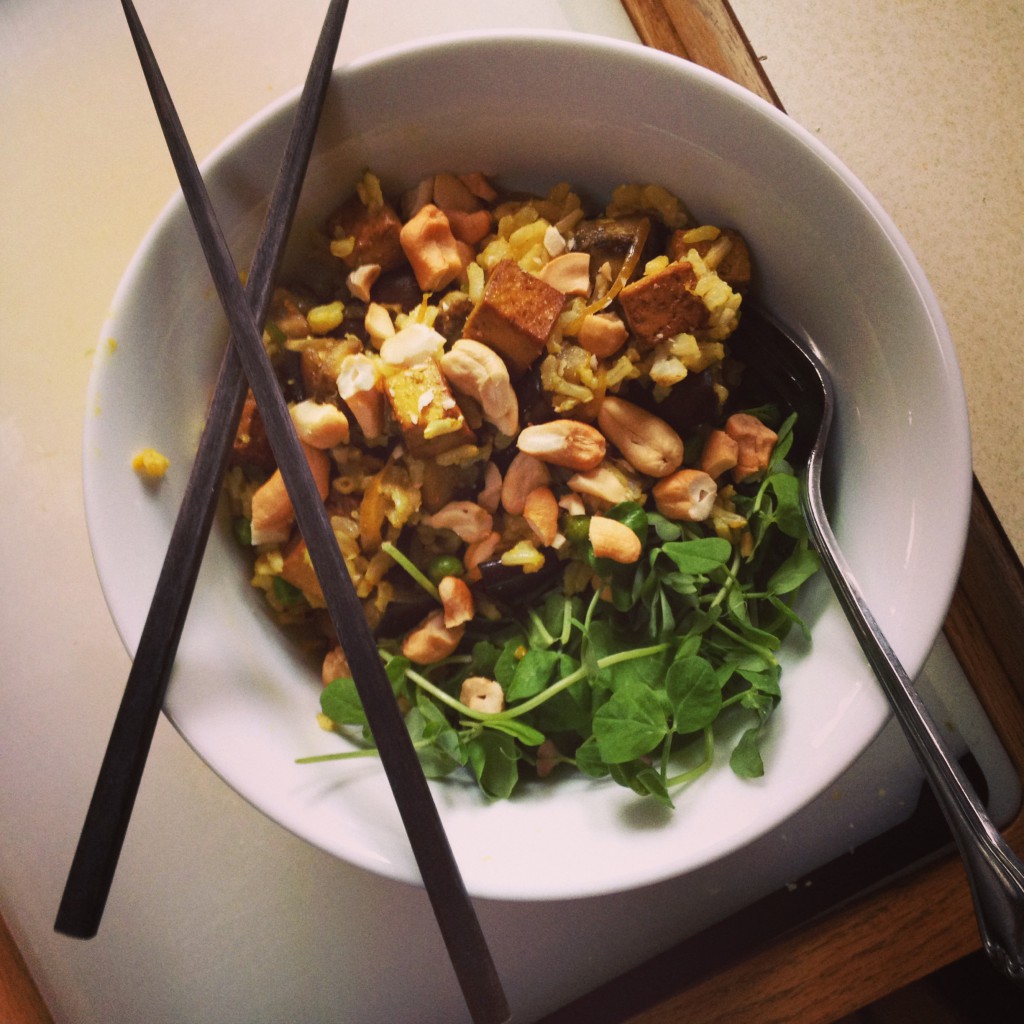
Come in to my kitchen…
June 27th, 2013
| 1 Comment »
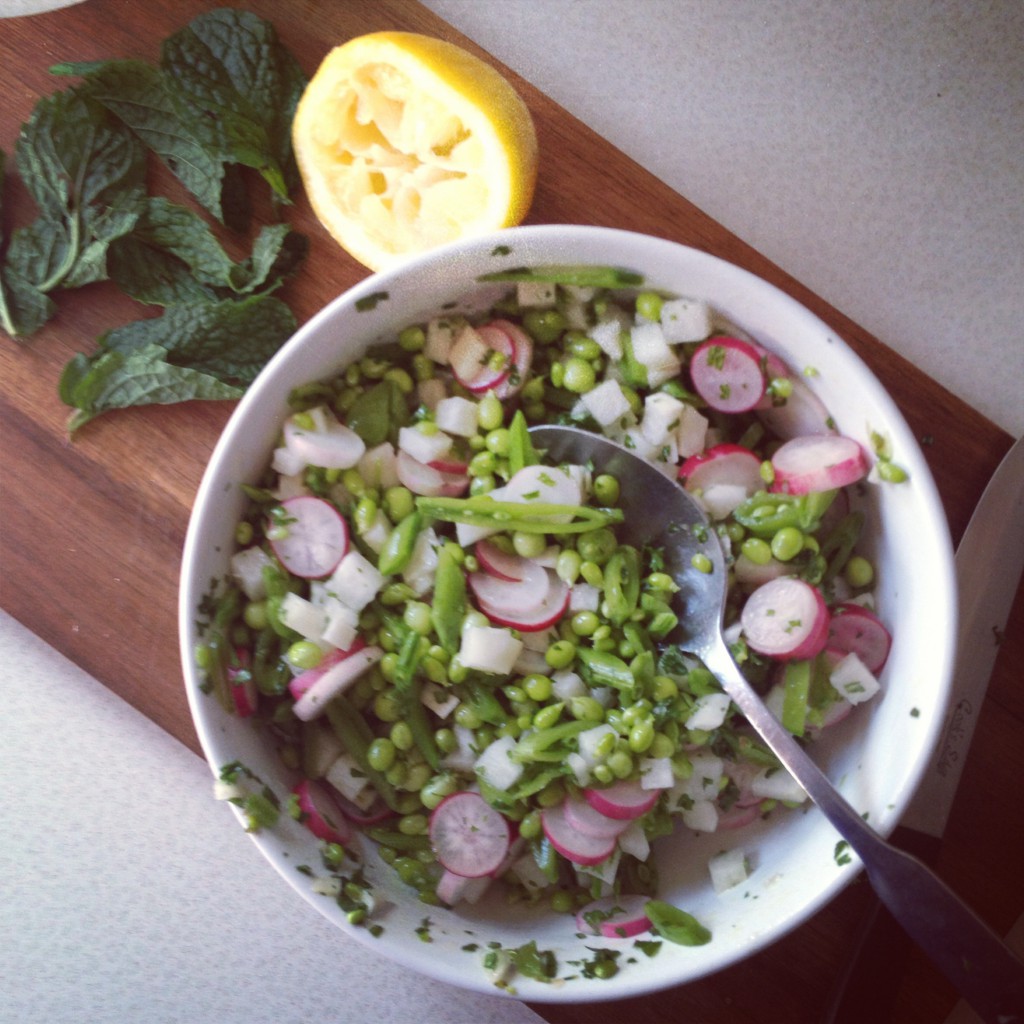
I’m fairly certain that you don’t feel like cooking when the heat index soars. No one really does, and even though we’re still a bit behind on our growing season, the bounty at the Farmers Markets is such that you can arrive home, dripping from a hot, steamy walk among the tables with an overflowing sack of fresh vegetables and make something cool, refreshing and satisfying for dinner without turning on your oven. Like this raw pea salad.
Come in to my kitchen…
May 20th, 2013
| 1 Comment »
I have an embarrassingly high number of veggie burger recipes neatly tucked away in a three-ring binder in the kitchen cupboard where all my cookbooks reside. There are more on my Pinterest site where I stash all the tidbits and delicacies found on the Internet. Every time I come across one on someone’s blog, I’d gaze at it longingly, mouth watering, as I glance over the ingredients.
But up until last week, I had made exactly ZERO of these recipes.
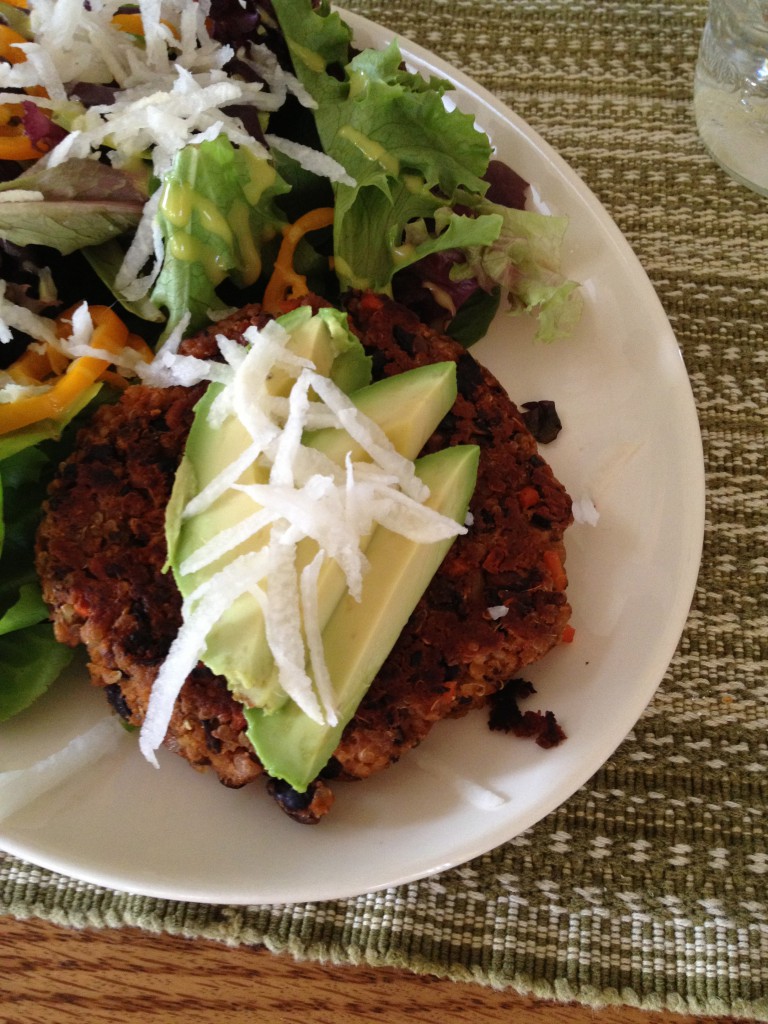
Come in to my kitchen…
March 25th, 2013
| 3 Comments »
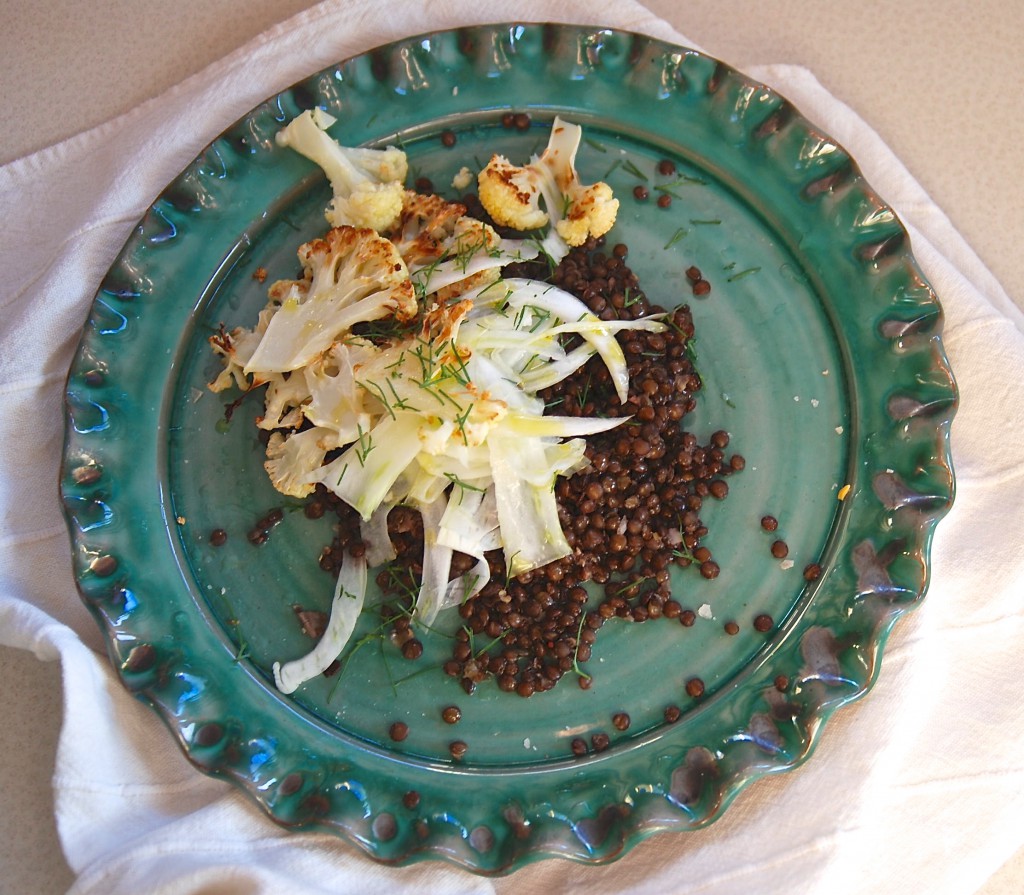
The daylight was fading fast, with a raging hunger, this simple idea, untried and uncertain was forming in my head. I had no idea if it was even going to taste good or not. I put it all on a plate, and crossed my fingers.
Come in to my kitchen…
|




















